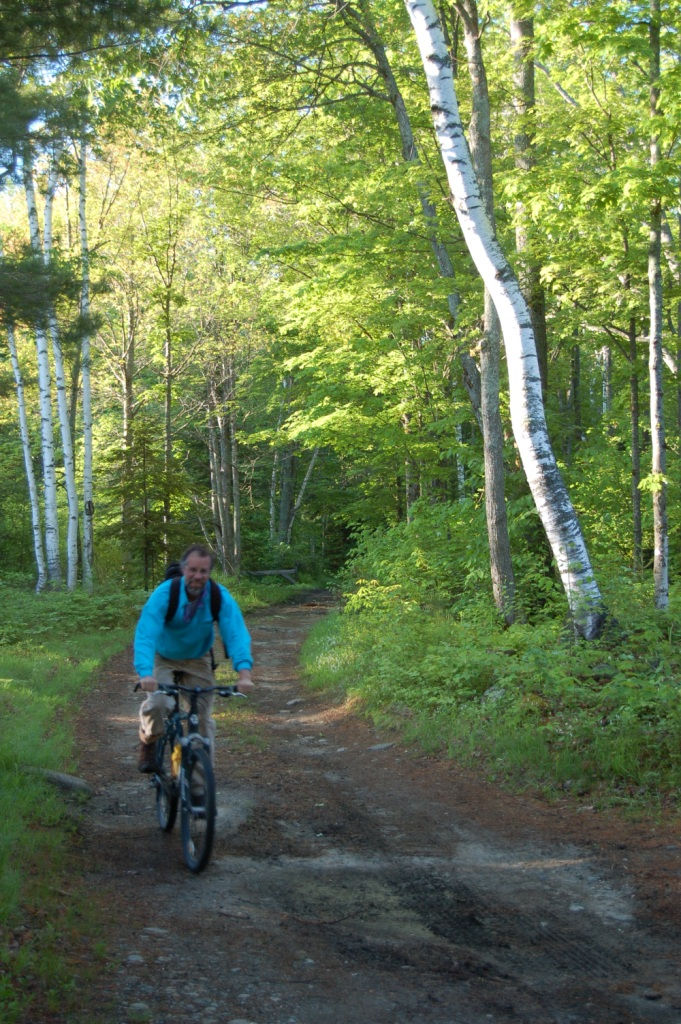Timber Frame
Building Process
Cutting of the timber frame took about three months. During this time most of the timber frame craftsmen stayed on the property during the week and traveled back home during the weekend. They were "ruffing it" during the week by staying in the cabins that are next to Cummins Pond. They used bikes, canoes and kayaks to commute from their cabins to the Barn House construction site as a part of the conservation process.
The "ruffing it" wasn't so bad since they also used the wood fired sauna and hot tub that are right on the pond and enjoyed the hospitality of the Alden Inn restaurant in town once a week. The beavers and loons made room for their daily swim in the pond and the wives and significant others enjoyed their wilderness visits when they joined them.




Where Do Houses Come From?
We become more and more removed from the souce of the products we used and consume. Whether it be the food we eat or the cloths we wear or where our homes come from. In planning the design of an environmentally friendly house we not only want to examine the health effects of living in the house but where all of the components come from.
In an effort to stay as natural as possible in building the Barn House, all the wood products used for the building will come from trees that are grown on our property in a sustainable managed manner.
Different trees will be used for different purposes in the Barn House. Using a natural renewable wood from a sustainable forest actually helps to preserve the forest, not deplete the resource.
If owners of forests in this country are able to market their wood as building material at a profitable price, then it will encourage the investment of growing that resource for the 50 to 70 years it takes to produce a financially viable high end product.

Every tree that was used for the building was specifically marked by our forester Quentin Mack
Yes, I am saying that the best way to save the forest is to responsibly and sustainably cut trees so the private landowners of these forests get a reasonable return on their investment.
Timber Frame Markings

Timber Frame Markings to indicate how to put the pieces together

Timber Frame Markings to indicate how to put the pieces together

Timber Frame Markings to indicate how to put the pieces together

Timber Frame Markings to indicate how to put the pieces together
Various Timber Frame Joints

Timber Frame Joint

Timber Frame Joint

Timber Frame Joint

Timber Frame Joint
Foundation Instulation

Foundation Installation

Foundation Installation

Foundation Installation

Foundation Installation
Timber Frame Raising First Floor
Below are a few pictures of the first floor installation. The first floor is made of four sections and each section was assembled on the ground and then raised with a 36 ton crain onto the foundation.
After the first floor timber frame is secured to the foundation walls and decked the foundation will be backfilled.

First Floor Installation

First Floor Installation

First Floor Installation

First Floor Installation
Timber Frame Sealing and Finishing
All of the main posts and beams are "adsed". This is a process of taking a tool that looks like a axe head that is positioned horizontally on it's handle and swinging it between one's feet until the complete timber is carved as showed below.
The braces in the main room are all organically shaped cherry. We utilized "bent" cherry trees which normally would not be used as a saw log product but they if part of a timber harvest would be used as chips. This way we were able to utilize a normal waste product and turn it into a fine piece of almost furniture.
They cherry logs are first sliced in half and them the bark is peeled with a draw knife and chisel. This allows the heart wood and the cambium of the log to show.
After the timbers are either adsed or peeled they are then plane sanded and then a finer hand sanding is done.
We then needed to protect the wood with an sealer. We chose to use an environmentally safe product called BioShield. Each timber will receive four coats of sealer, two before the timber frame gets put together and two after most of the construction work is finished. We chose to use a clear sealer and not to apply any stain to the wood. With a clear finish the natural beauty of the wood is allowed to come through and the different types of wood can be more easily distinguished.

Timber Sealing and Finishing

Timber Sealing and Finishing

Timber Sealing and Finishing

Timber Sealing and Finishing
Roof Raising

Roof Raising

Roof Raising

Roof Raising

Roof Raising
Dedication and Completion

Dedication and Completion

Dedication and Completion

Dedication and Completion

Dedication and Completion